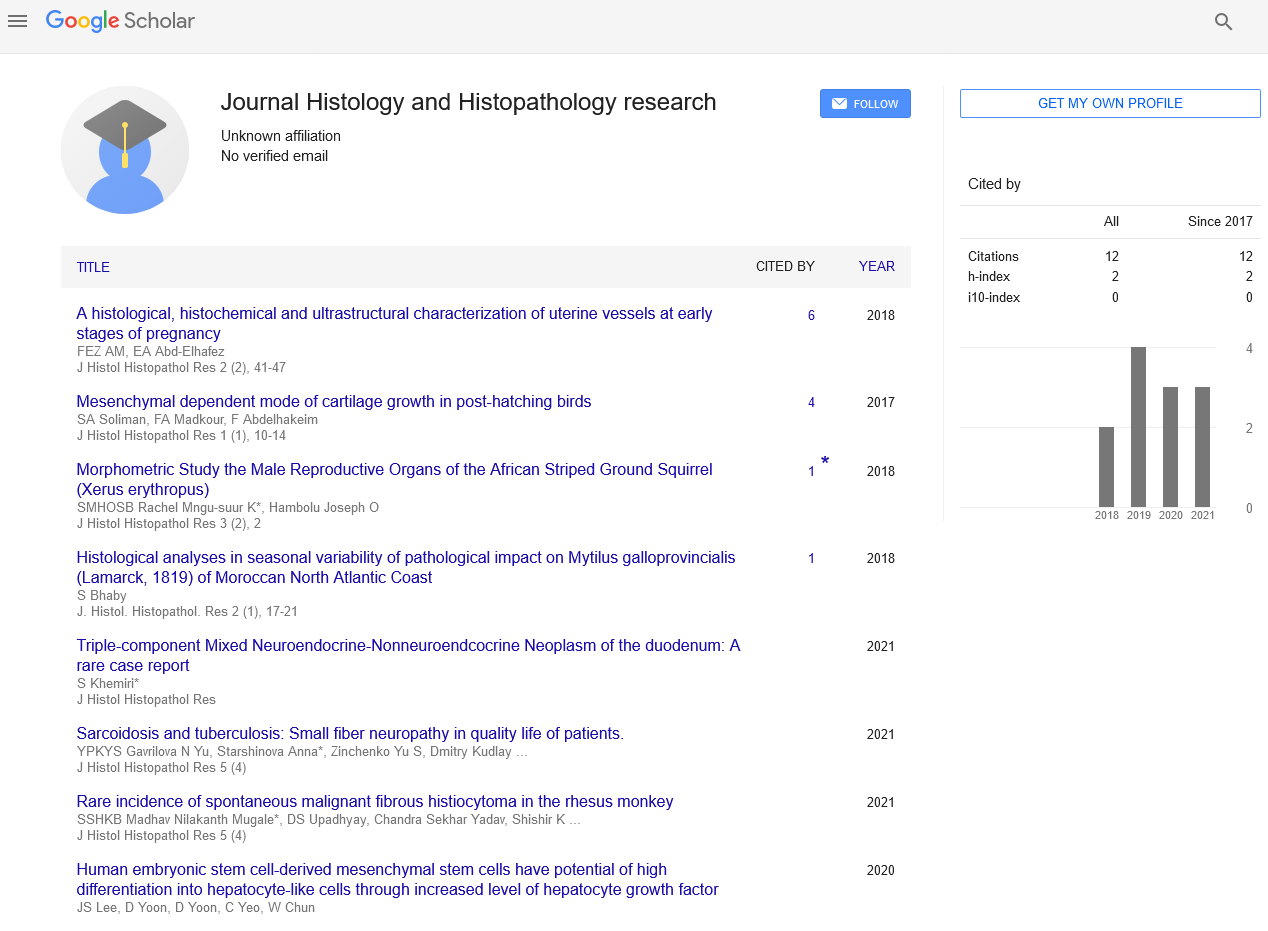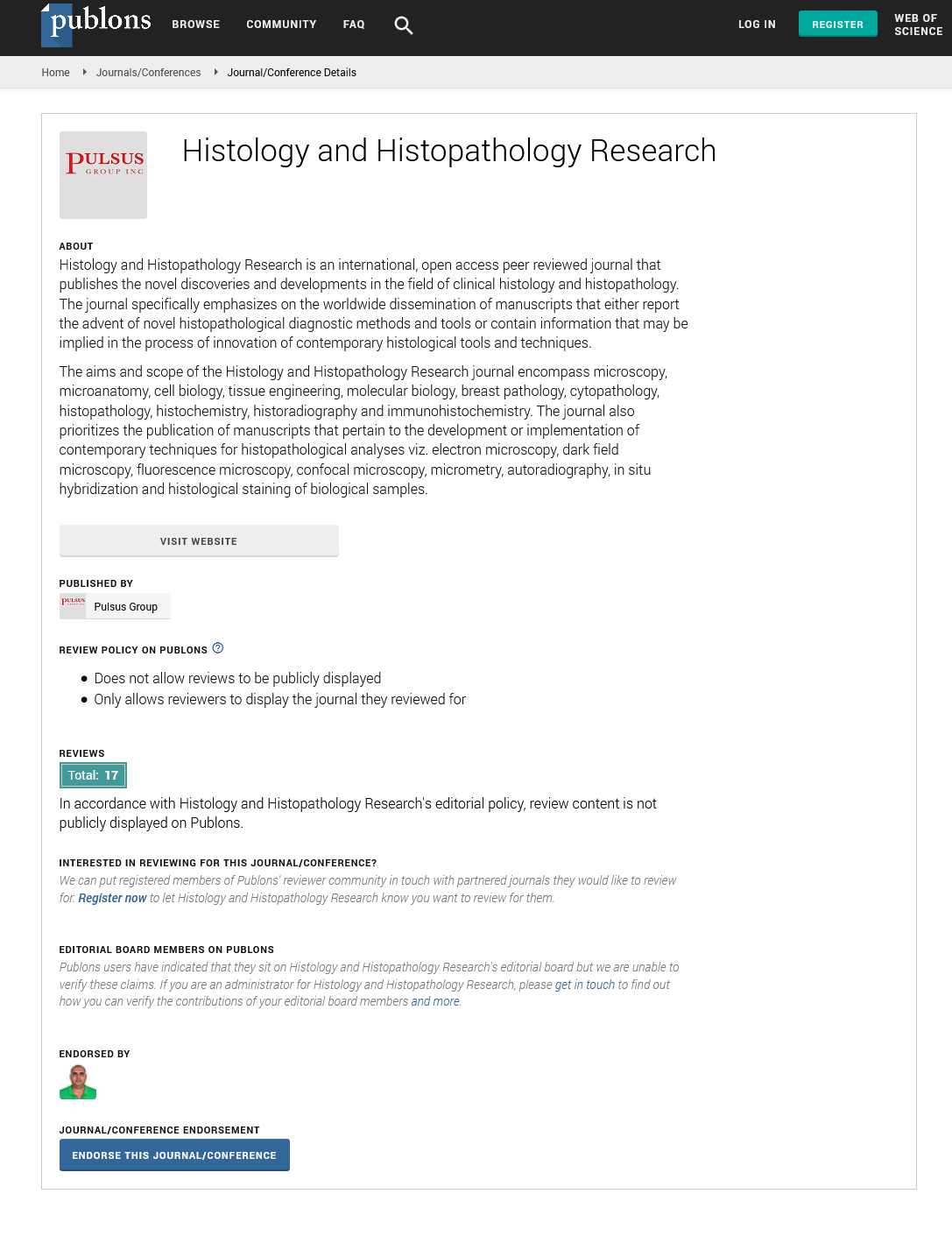A histochemical study examined the development of the human nucleus basalis complex and associated fibre systems during pregnancy
Received: 01-Jul-2022, Manuscript No. PULHHR-22-5543; Editor assigned: 04-Jul-2022, Pre QC No. PULHHR-22-5543 (PQ); Accepted Date: Jul 19, 2022; Reviewed: 14-Jul-2022 QC No. PULHHR-22-5543 (Q); Revised: 16-Jul-2022, Manuscript No. PULHHR-22-5543 (R); Published: 25-Jul-2022, DOI: 10.37532. pulhhr.22. 6 (4).83-84
Citation: Wan D. A histochemical study examined the development of the human nucleus basalis complex and associated fibre systems during pregnancy. J Histol Histopathol Res. 2022;6(4):83-84.
This open-access article is distributed under the terms of the Creative Commons Attribution Non-Commercial License (CC BY-NC) (http://creativecommons.org/licenses/by-nc/4.0/), which permits reuse, distribution and reproduction of the article, provided that the original work is properly cited and the reuse is restricted to noncommercial purposes. For commercial reuse, contact reprints@pulsus.com
Introduction
We have examined the prenatal development of histochemical reactivity in the nucleus basalis complex to offer criteria for research into the "cholinergic" innervation of a human foetal cerebrum (a magnocellular complex known to contain a high concentration of cholinergic perikarya). For the purpose of showing acetylcholinesterase activity, frozen, chopped, and processed brains from foetuses and preterm newborns between 8 and 35 weeks of gestation were used. The total cholinesterase reactivity was used to express the histochemical reactivity for early stages because inhibitors could not consistently provide findings on material older than 1.5 weeks. As early as 9 weeks of gestation, a dark cholinesterase reactive "spot" may be seen between the surface of the basal telencephalon and the developing lenticular nucleus. This is the earliest indication of basal telencephalon histochemical differentiation. The strongly reactive fibre system located along the dorsal side of the optic tract is connected to this reactive region (nucleus basalis complex anlage) by the first cholinesterase reactive bundle. The nucleus basalis complex grows significantly in size during the following "stage" (10.5 weeks), and sublenticular, diagonal, and septal regions are occupied by highly cholinesterase reactive neuropil. Currently, we can observe two new cholinesterase-reactive bundles: one large bundle travelling towards the medial limbic cortex through the precommissural septum and another smaller bundle reaching (but not piercing) the neocortical anlage through the external capsule. The pregeniculate region and the tegmentum are now the locations of the supraoptic fibre system.
current fascination with the basalis nucleus and surrounding Large, Acetylcholinesterase (AChE) reactive, and cholineacetyl transferasecontaining neurons of the nucleus basalis serve as a single major source of cholinergic innervation for the primate cerebral cortex, according to experimental evidence in monkeys. Analogous evidence in humans regarding the relationship between the basal forebrain and cortex has been found in biochemical, immunocytochemical, and neuroanatomical studies of Alzheimer's disease Studies on the biochemistry of human brains in Alzheimer's disease showed that a sizable A reduction in choline acetyltransferase activity in the nucleus basalis is linked to a decrease in cortical cholinergic indicators. One must remember that, in contrast to the immunohistochemical findings in rodents, the immunocytochemical findings in primates do not demonstrate evidence of cortical intrinsic cholinergic neurons when considering basal forebrain cholinergic deficit as a potential cause of decreased cholinergic innervation. Therefore, choline acetyltransferase-containing cholinergic neurons in the human nucleus basalis and associated basal forebrain nuclei have significantly decreased or shrunk, according to immunocytochemical experiments using monoclonal antibodies on brain tissue in the dementia of the Alzheimer's type. Since the cholinergic synthesis enzyme is present in more than 90% of big neurons in the nucleus basalis, neuropathological NissI results of large neuron loss in the nucleus basalis in Alzheimer's disease may provide additional indirect support for this basal forebrain cholinergic theory.
The human foetal brain is made up of temporary compartments, according to histology research. These compartments go through structural remodelling during prenatal and postnatal development and serve as the locations of important neurogenic processes. Consequently, the shape of the prenatal and newborn brain evolves first from day to day, then from week to week. Ex vivo and in vivo structural MRI and DTI have been effectively used to study the spatio-temporal alterations in these transitory compartments, albeit histology is still the gold standard for their characterization. The progressive development of axonal connection takes place concurrently with the structural remodelling of the transitory foetal compartments. DTI and tractography, both ex vivo and in vivo, can be used to evaluate the development of structural connections. Ex vivo and in vivo MRI studies have shown that the cerebral cortex matures from the primary to the association cortices, and that the development of the limbic and projection axonal pathways occurs before that of the association ones. We go into great depth about the structural development of the prenatal human brain in this part, focusing on MRI methods.
Immunologists have been captivated by the mother-fetus interaction for a long time. In 1953, Billingham cited the semiallogeneic foetus' survival as proof that the mother immune system may tolerate the foetus. To explain the survival of the "immunogenic" foetus, many theories regarding placental protection of the foetus have been proposed. These theories include maternal immune tolerance to foetal antigens, expression (or lack of expression) of histocompatibility antigens on foetal tissues, inhibition and/or regulation of maternal antifetal immune responses, and many others. The mechanics haven't been fully understood yet, though. The variety among species in which such studies are carried out contributes to the complexity of investigating these systems. The first symptom of basal telencephalon histochemical differentiation is the emergence of a dark, rather large Cholinesterase (ChE) reactive "spot" under the anlage of lentiform nucleus in a 9-week-old foetus (putamen and pallidum are not well differentiated during this stage). The paleo-cortical surface of the basal telencephalon is separated from this ChE reactive area below by a ChE negative domain. Before the time when one may cytoarchitectonically delinate NB, the neuropil's early ChE reaction manifests. We so suggest the name nucleus basalis complex aniage. The earliest ChE reactivity in the entire telencephalon is seen in this anlage. The nucleus Basahs Complexanlage is connected to the first ChE reactive bundle in the telencephalon; a thick, strongly reactive bundle that emerges from it travels ventrally and caudally before joining the strongly reactive diencephalic fibre system that is located along the dorsal side of the optic tract. These fibres will be referred to as the supraoptic fibre system in the following material. ChE reactivity is restricted to the neuropil, and at this early stage of development, no ChE reactive perikarya were seen.






